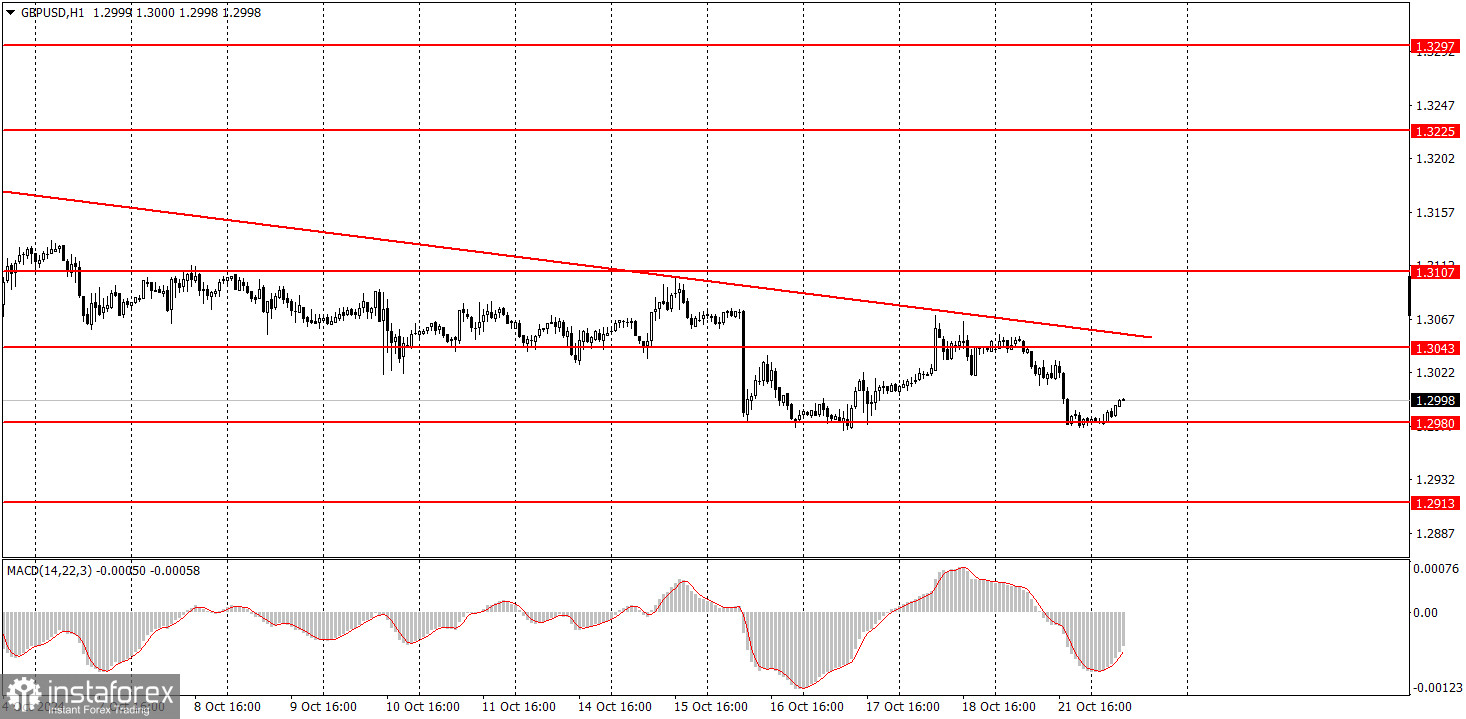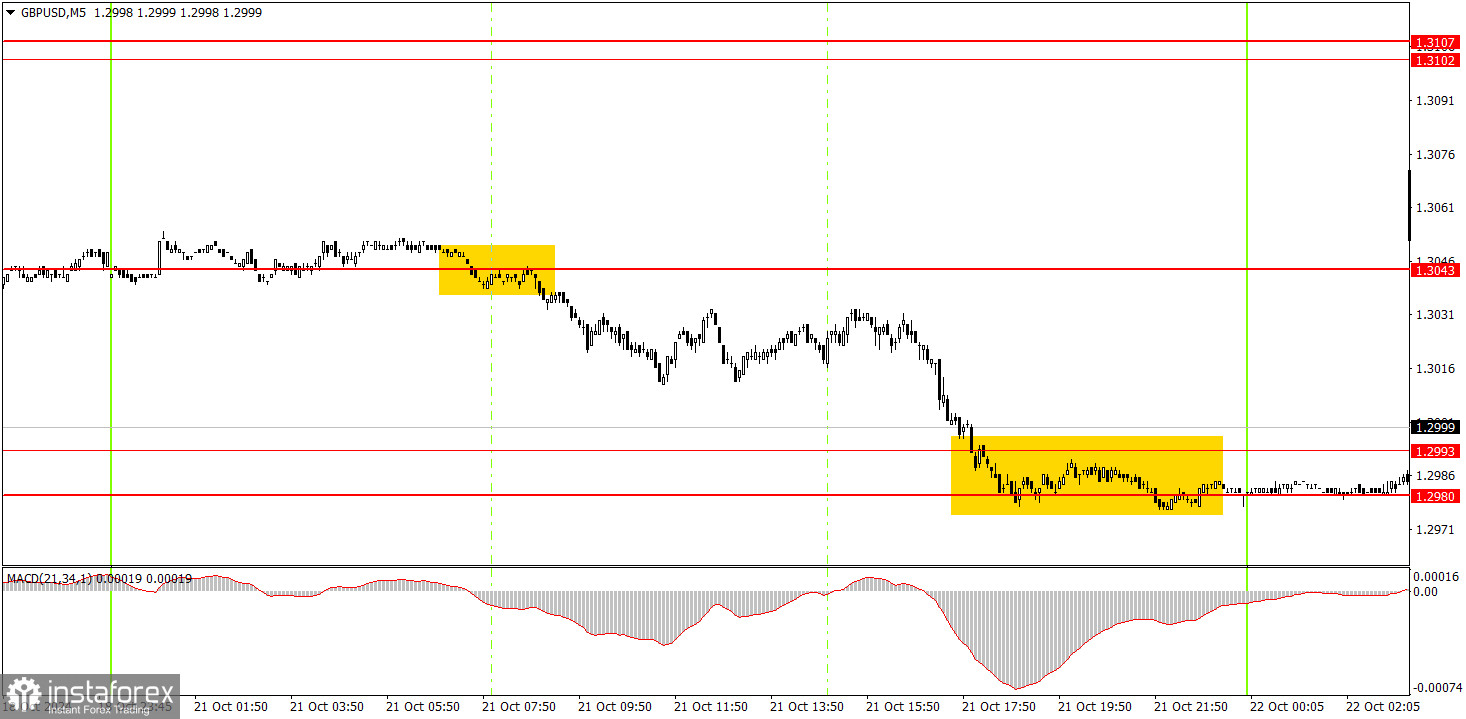Analysis of Monday's Trades
1H Chart of the GBP/USD Pair

On Monday, the GBP/USD pair also traded lower despite the absence of any specific reasons or catalysts. Nevertheless, the British currency fell for the third time to the 1.2980 level, near the psychological mark of 1.3000. This indicates a clear desire by the market to establish a position below this level and continue declining. This process might be more complex than simply breaking below the 1.3000 level and then plunging further. The price could break through this level, enter a correction, consolidate above the trendline, and only then resume its decline. However, the bearish sentiment in the market is undeniable. On Monday, no significant or noteworthy events occurred in the UK or the US. Today, no such events are expected either. The price could bounce off the 1.2980 level for the third time but may make a fourth attempt to break through this level.
5M Chart of the GBP/USD Pair

Only one trading signal was formed in the 5-minute time frame on Monday. At the very start of the European trading session, the price broke through the 1.3043 level, after which it dropped back into the 1.2980-1.2993 area. Thus, novice traders could open a single sell trade, yielding a profit of around 50 pips. We would not recommend trading on a rebound from the 1.2980-1.2993 area.
How to Trade on Tuesday:
In the hourly time frame, the GBP/USD pair broke the upward trend and continued to decline. We fully support the pair's decline in the medium term, as we believe it is the only logical direction. The pound may attempt to correct in the near future, but to confirm this, the price would need to consolidate above the trendline. In any case, current volatility is low, so expecting a strong and rapid rise is unrealistic.
The pair could continue its downward movement on Tuesday, as the trendline has not been broken. As long as the price remains below the trendline, discussing buy opportunities is irrelevant. Even in that scenario, any upward movement would only be a correction.
In the 5-minute time frame, trading can currently be conducted around the levels of 1.2848-1.2860, 1.2913, 1.2980-1.2993, 1.3043, 1.3102-1.3107, 1.3145-1.3167, 1.3225, 1.3272, 1.3365, 1.3428-1.3440. No significant events are scheduled in the UK or the US on Tuesday. As a result, volatility may remain low, but traders still have enough technical reference points to trade based solely on them.
Basic Rules of the Trading System:
- The strength of a signal is determined by the time it takes to form (bounce or break through a level). The less time it takes, the stronger the signal.
- If two or more trades were opened with false signals around a certain level, all subsequent signals from that level should be ignored.
- In a flat market, any pair can generate many false signals or none at all. In any case, it's better to stop trading at the first signs of a flat market.
- Trading should be done between the start of the European session and the middle of the American session, after which all trades should be closed manually.
- On the hourly time frame, trade signals from the MACD indicator are best used when there is good volatility and a trend confirmed by a trendline or channel.
- If two levels are too close to each other (5 to 20 pips apart), consider them as a support or resistance zone.
- When the price moves 20 pips in the intended direction, set a Stop Loss to break even.
What's on the Charts:
Support and Resistance Price Levels: These levels serve as targets when opening buy or sell positions. They can also be used as points to set Take Profit levels.
Red Lines: These represent channels or trend lines that display the current trend and indicate the preferred trading direction.
MACD Indicator (14,22,3): The histogram and signal line serve as a supplementary indicator that can also be used as a source of trading signals.
Important Speeches and Reports (always found in the news calendar) can significantly impact the movement of a currency pair. Therefore, trading should be done with maximum caution during their release, or you may choose to exit the market to avoid a sharp price reversal against the preceding movement.
For Beginners Trading on the Forex Market: It's essential to remember that not every trade will be profitable. Developing a clear strategy and practicing money management is key to achieving long-term success in trading.





















